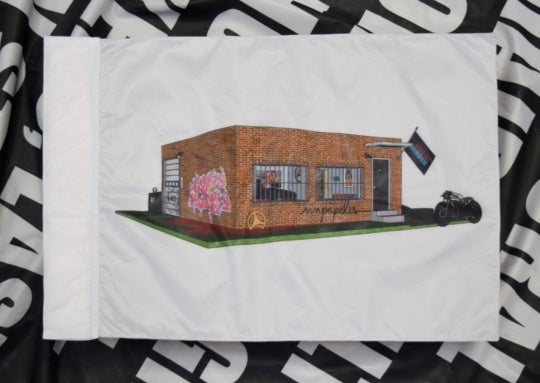
In the press release for his Phantom Engineer project at Vanderbilt University’s Space 204 [which ran through October 29], Vanderbilt Department of Art lecturer John Warren describes the work as a “cine-installation.” I’ve never seen the term used before, but it’s a good one here: Warren’s installation includes three loops of 16mm film projected from three separate projectors, creating a triptych of moving images on the wall of the dark gallery. In the broadest sense, Phantom is a collection of images of trains and tracks from all over Nashville. More importantly, it’s a work that documents a city undergoing dynamic change, it’s a love letter to analog and mechanical art, and the installation playfully subverts viewer’s expectations by ignoring that false line that separates video art in a gallery from films shown in a theater.
Warren shot his factory walls, woods, bridges, and streets using a 16mm camera fixed to a tripod. After getting his shot, Warren left his camera in place, cranked the film back to the first frame, and shot the same shot again once a train rolled through. The resulting footage includes speeded-up boxcars, slow motion locomotives, empty tracks captured in soft-focus and clear light, and double-exposed images that evoke memories, ghosts, the progressive march of time, the frantic pace of the present, and just a hint of nostalgia for each whirring frame.

Like many cities, Nashville’s undergoing a growth boom, that’s catalyzed a building boom, and that’s threatening to remake the city to satisfy the whims of real estate and development. Within such an environment, all art that documents the city in the midst of these changes takes on a gravitas that isn’t lost on viewers of Warren’s project. The artist captures the city’s capitol building, the old address of the music venue the Family Wash in East Nashville, the western wall of the Track One building in the Wedgewood-Houston neighborhood, street art, and a number of neighborhood streets and natural settings that all speak to the sensibility of the city as it is today.
All of Warren’s representations of the physical cityscape are reinforced by the material presence of the installation itself. Unlike the typical display of video art within a gallery — projected from faint-sounding digital projectors discreetly mounted to the ceiling — which create the illusion that the image is appearing on the wall out of its own luminous volition, Warren’s projectors are large and mobile, and they make a hell of a clackety racket, not unlike a train. Here, the actual loops of film can be seen stretching between the reels and before the bulbs: The center projector depicts leaves falling on empty tracks, with a loop just long enough to pass through the projector and the reels before it once again connects back to itself. The two outside projectors are each fitted with a piece of gear called a “looper,” an extra reel that fits on the top of the projector, allowing Warren to physically loop what seems like about five full minutes of film.

I was thrown off for a second because I couldn’t quite figure out how he had configured such a long loop that actually worked. Yet, this confusion provides a prime example of how Warren’s cinematic techniques subvert expectations of imagery on a gallery wall and vice versa. Even though the triptych points to painting, this is moving photography. Warren has used a film camera and film projectors to capture and present that kind of poetic collage of visual associations that would never screen in a mainstream movie theater. Hence, attempts to peg Warren as a traditional filmmaker or a contemporary video artist are all met with contradictions.

In addition to the mechanical noise, Warren’s work is accompanied by a soundtrack consisting of sustained tones, sometimes sounding like ringing metal as well as sometimes sounding like singing voices. And here’s another dichotomy captured by Warren: the life of the city and our personal lives are as equally basic and profane as they are vital and transcendent.
While watching Warren’s trains crisscross on the gallery wall, I felt that little sense of wonder we sometimes glean when we remember how bizarre and beautiful it is just to be along for the ride.
Joe Nolan is a critic, columnist, and intermedia artist in Nashville. Find out more about his projects at www.joenolan.com.




